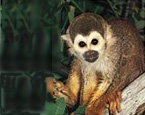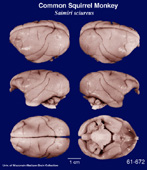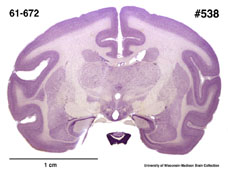|
Common
Squirrel Monkey
(Saimiri sciureus) #61-672 |
||||
|
|
Physical
characteristics and distribution
|
|
Head
and body length of S. sciureus is 260-360 mm, tail length
is 350-425 mm, weight ranges from 750-1,100 grams. The short,
thick, soft fur is brightly colored and there is a circular
patch around the lips and nostrils which is hairless. Coloration
varies, but most commonly the markings are as follows: white
around the eyes extending behind the ears, down the sides of
the throat and neck; gray to black on the top of the head, reddish
or yellow forearms, hands and feet with the shoulders and hind
feet touched with gray; underparts white to ochre; and the tail
colored similarly to the body, but with the terminal portion
black. Coloration and markings are similar in all ages and both
sexes. The large eyes are closely set and the ears are shaped
like human ears. S. sciureus has a short but well-developed
thumb and a long tail which is not prehensile. They
do appear to be particularly territorial. This primate forms
larger groups than any other New World Monkeys. Social subgroups
are often comprised of pregnant females, females with young,
and adult males. The mating season reveals and hierarchy achieved
by fierce fighting, and the dominant males interacting with
the females. Once the females give birth they form a subgroup
which excludes the males and likely has a hierarchy of its own.
Another subgroup of young males and preadult males, has individuals
who leave to join the adult males as they reach sexual maturity,
sometimes being required to fight to win a place in this group.
S. sciureus is among the most vocal of all primates using
chirps and squeaks for alarm, squawks and purrs during mating
and birth seasons, barks of aggression and screams when in pain.
26 distinct calls have been recorded in these monkeys. |
|
Description
of the brain
|
|
Animal
source and preparation
|
|
All
specimens collected followed the same preparation
and histological procedure.
|
Other Related Resources (websites and publications)
List of Specimens | Explore Collections | Brain Sections | Brain Evolution | Brain Development | Brain Circuitry | Brain Functions | Location and Use | Related Web Sites | Contact Us | Search MSU Database | Personnel | Home



